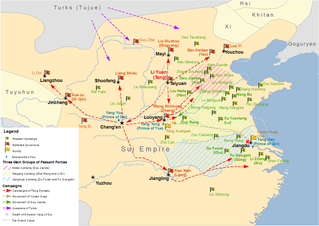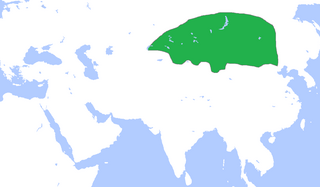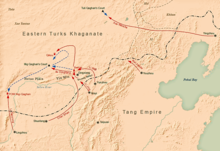
Emperor Taizong of Tang, previously Prince of Qin, personal name Li Shimin, was the second emperor of the Tang dynasty of China, ruling from 626 to 649. He is traditionally regarded as a co-founder of the dynasty for his role in encouraging his father Li Yuan to rebel against the Sui dynasty at Jinyang in 617. Taizong subsequently played a pivotal role in defeating several of the dynasty's most dangerous opponents and solidifying its rule over China proper.
Shibi Khagan succeeded Yami Qaghan as the second khagan of the Eastern Turkic Khaganate.
Ashina Xichun, also known as Chuluo Khagan, was the khagan of the Eastern Turkic Khaganate, and second son of Yami Qaghan. He succeeded his elder brother Shibi and ruled for 18 months.
Illig Qaghan, born Ashina Duobi, posthumous name Prince Huang of Guiyi (歸義荒王), was the last qaghan of the Eastern Turkic Khaganate.
Liang Shidu (梁師都) was an agrarian leader who rebelled against the rule of the Chinese Sui dynasty near the end of the reign of Emperor Yang of Sui. He, claiming the title of Emperor of Liang with the aid from Eastern Turkic Khaganate retained the modern northern Shaanxi and western Inner Mongolia region for over a decade, but was gradually weakened by attacks from the Tang dynasty, whose founding emperor Emperor Gaozu and successor Emperor Taizong had eliminated the rival contenders for power one by one, leaving Liang isolated. In 628, with the Eastern Turks in internal turmoil and unable to come to his aid, Emperor Taizong launched another attack on Liang. Liang's cousin Liang Luoren (梁洛仁) assassinated him and surrendered, completing Tang's drive to reunite China after Sui's collapse.

The transition from Sui to Tang (613–628), or simply the Sui-Tang transition, was the period of Chinese history between the end of the Sui dynasty and the start of the Tang dynasty. The Sui dynasty's territories were carved into a handful of short-lived states by its officials, generals, and agrarian rebel leaders. A process of elimination and annexation followed that ultimately culminated in the consolidation of the Tang dynasty by the former Sui general Li Yuan. Near the end of the Sui, Li Yuan installed the puppet child emperor Yang You. Li later executed Yang and proclaimed himself emperor of the new Tang dynasty.

The Xueyantuo were an ancient Tiele tribe and khaganate in Northeast Asia who were at one point vassals of the Göktürks, later aligning with the Tang dynasty against the Eastern Göktürks.

The Eastern Turkic Khaganate was a Turkic khaganate formed as a result of the internecine wars in the beginning of the 7th century after the First Turkic Khaganate had splintered into two polities – one in the east and the other in the west. Finally, the Eastern Turkic Khaganate was defeated and absorbed by the Tang dynasty, and Xueyantuo occupied the territory of the former Turkic Khaganate.
The Emperor Taizong of Tang, the second emperor of the Tang dynasty, early in his reign, had allied with Xueyantuo, a vassal of the powerful Eastern Turkic Khaganate, against Eastern Turks, who Tang defeated in 630. Upon Eastern Turks' defeat, Xueyantuo's Zhenzhu Khan Yi'nan took over Eastern Turks' former territory, and while he was formally submissive to Tang, he was expanding his own strength. When Emperor Taizong tried to restore Eastern Turks in 639 under the Qilibi Khan Ashina Simo to counteract the rise of Xueyantuo power, Xueyantuo engaged in multiple battles with the newly restored Eastern Turks, in order to prevent this return. The major Tang general Li Shiji temporarily came to protect Eastern Turks against Xueyantuo and defeated the Xueyantuo forces in 641. But in 644, with Emperor Taizong occupied with a campaign against Goguryeo, Xueyantuo forces launched a new campaign, defeated Eastern Turks, forcing Ashina Simo to flee back to Tang. Subsequently, Goguryeo sought aid from Xueyantuo, but Yi'nan avoided further conflict, wanting to avoid direct battle with Tang. After Yi'nan's death in 645, however, his son Duomi Khan Bazhuo began heavily battling Tang forces. In 646, Tang forces counterattacked, and after they defeated Bazhuo, Xueyantuo's vassal Huige rose and killed him. His cousin, the Yitewushi Khan Duomozhi, surrendered to Tang forces, ending Xueyantuo.

In the years following Tang Taizong's subjugation of the Eastern Turkic Khaganate, the emperor began to exert his military power toward the oasis city-states of the Tarim Basin. These states, populated by Tocharian and Saka peoples, were loosely allied with the Western Turkic Khaganate. In 640, Emperor Taizong sent the military commander Hou Junji to defeat and annex Gaochang (Karakhoja)—the first attempt by any Chinese dynasty to set up a permanent military and political presence in the region since Fu Jian in the 4th century. In 644, after Karasahr (Yanqi)—an ally in the campaign against Karakhoja—turned against Tang and allied with the Western Turkic Khaganate, the Tang commandant at Karakhoja, Guo Xiaoke, attacked and captured the King of Karasahr, Long Tuqizhi, but Karasahr subsequently rebelled. In 648, the ethnically Turkic Tang general Ashina She'er who was the second son of Shibi Khan, attacked both Karasahr and Kucha in the northern Tarim, conquering both. Kashgar and Khotan in the western Tarim then also submitted to Tang, allowing the dynasty to dominate the region until it was briefly seized by Tibet during the reign of Emperor Taizong's son Emperor Gaozong.
Qilibi Khan, personal name Ashina Simo (阿史那思摩), Chinese name Li Simo (李思摩), full regal title Yiminishuqilibi Khagan (乙彌泥孰俟力苾可汗), Tang noble title Prince of Huaihua (懷化王), was a member of the Eastern Tujue (Göktürk) royal house who was given the title of Khan of Eastern Tujue for several years, as a vassal of the Chinese Tang dynasty.

Zhenzhu Khan was a khan of Xueyantuo, under whom Xueyantuo rose from being a vassal of Eastern Tujue to a mighty khanate ruling over northern and central Asia. His personal name was recorded as YishiYinan, latter being Chinese rendering of Inan. He was later bestowed with full regal title Zhenzhupijia Khan.
Chebi Khagan, reconstructed Old Turkic *Çavïş; personal name Ashina Hubo, full regal title Yizhuchebi Khagan, was a claimant of the title of khan of Eastern Turkic Khaganate after the collapse of Xueyantuo, who was successful for some time in reconstituting Eastern Turkic Khaganate, until he was defeated and captured by the Tang dynasty general Gao Kan (高侃) in 650.
The First Turkic Khaganate, also referred to as the First Turkic Empire, Göktürk Khaganate, or the Turkic Khaganate, was a Turkic khaganate established by the Ashina clan of the Göktürks in medieval Inner Asia under the leadership of Bumin Qaghan and his brother Istämi. The First Turkic Khaganate succeeded the Rouran Khaganate as the hegemonic power of the Mongolian Plateau and rapidly expanded their territories in Central Asia. The khaganate became the first Central Asian transcontinental empire from Manchuria to the Black Sea.
Ashina Jiesheshuai was a member of the Ashina clan of the Eastern Turkic Khaganate and general (Zhonglangjiang) of the Tang dynasty.
Ashina Funian was a Göktürk leader and member of the Ashina tribe who was the leader of one of the Göktürk revolts that tried to restore the Eastern Turkic Khaganate in the 7th century and break from Tang domination. His rebellion was unsuccessful and he was executed by the Tang authorities in 681.

The conquest of the Western Turks, known as the Western Tujue in Chinese sources, was a military campaign in 655–657 led by the Tang dynasty generals Su Dingfang and Cheng Zhijie against the Western Turkic Khaganate ruled by Ashina Helu. The Tang campaigns against the Western Turks began in 640 with the annexation of the Tarim Basin oasis state Gaochang, an ally of the Western Turks. Several of the oasis states had once been vassals of the Tang dynasty, but switched their allegiance to the Western Turks when they grew suspicious of the military ambitions of the Tang. Tang expansion into Central Asia continued with the conquest of Karasahr in 644 and Kucha in 648. Cheng Zhijie commanded the first foray against the West Tujue, and in 657 Su Dingfang commanded the main army dispatched against the Western Turks, while the Turkic generals Ashina Mishe and Ashina Buzhen led the side divisions. The Tang troops were reinforced by cavalry supplied by the Uyghurs, a tribe that had been allied with the Tang since their support for the Uyghur revolt against the Xueyantuo. Su Dingfang's army defeated Helu at the battle of Irtysh River.

The Battle of Yinshan was fought on 27 March 630 CE near the Yin mountain range close to the city of Dingxiang. Emperor Taizong (598-649) commissioned the famed Tang military officer Li Jing, along with Li Shiji, Wei Xiaojie, Li Daozong, Chai Shao (柴紹), and Xue Wanche (薛萬徹) to attack forces under the command of Illig Qaghan, leader of the Eastern Turkic Khaganate, a nomadic confederation of Turkic peoples based in Inner Asia. The battle ended in defeat for the Göktürks and resulted in the dissolution of the Eastern Turkic Khaganate, which was eventually replaced by the Protectorate General to Pacify the North, otherwise known as the Anbei Protectorate (安北都護府) in 647 CE after the Tang dynasty definitively conquered the Xueyantuo.
Ashina Shibobi — was a lesser khagan, who ruled the eastern wing of Eastern Turkic Khaganate.
Ashina She'er was a Turkic prince and general in Tang military. He also briefly claimed the Western Turkic Khaganate in 628-634 centered around Beshbaliq.














